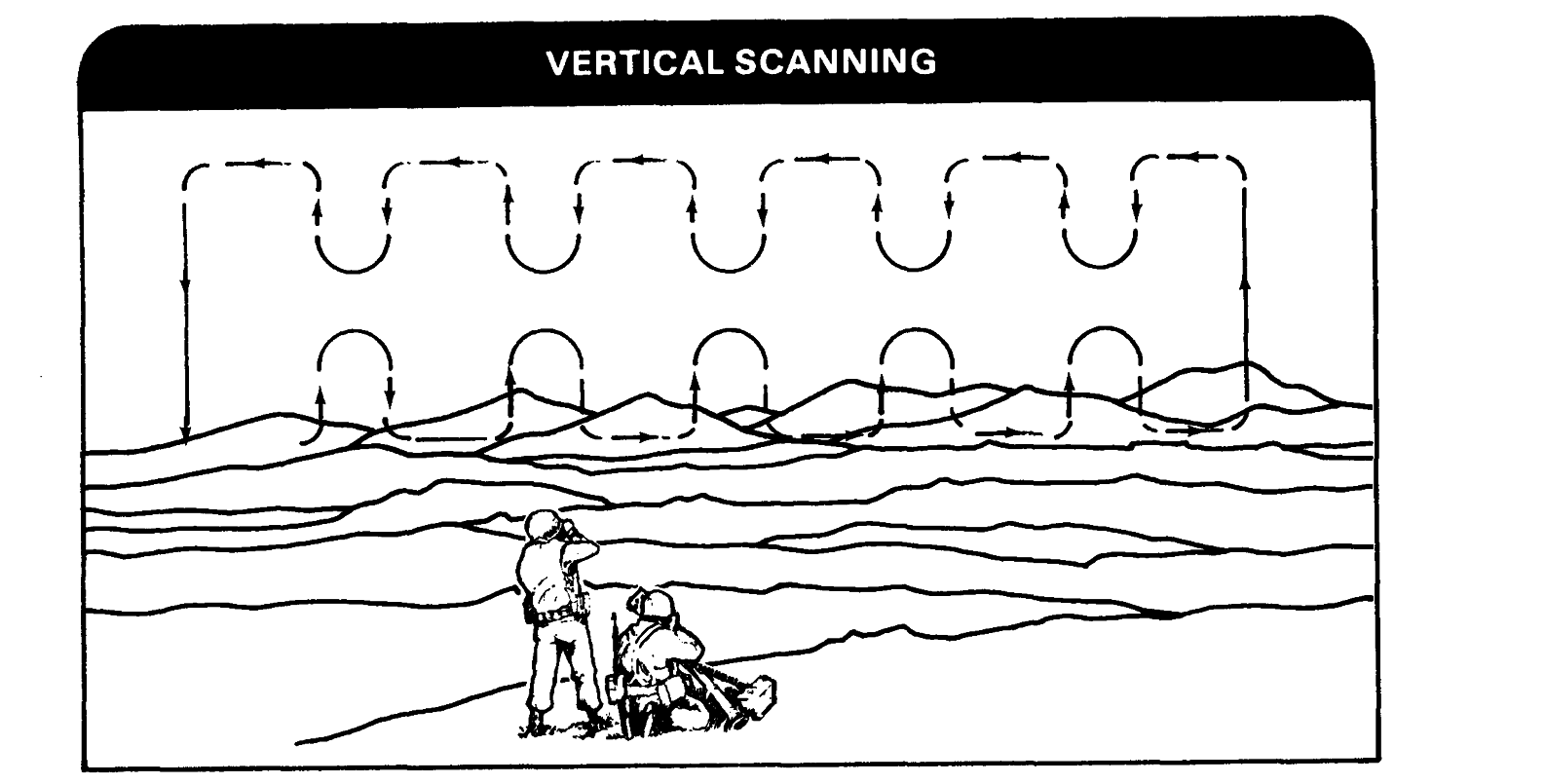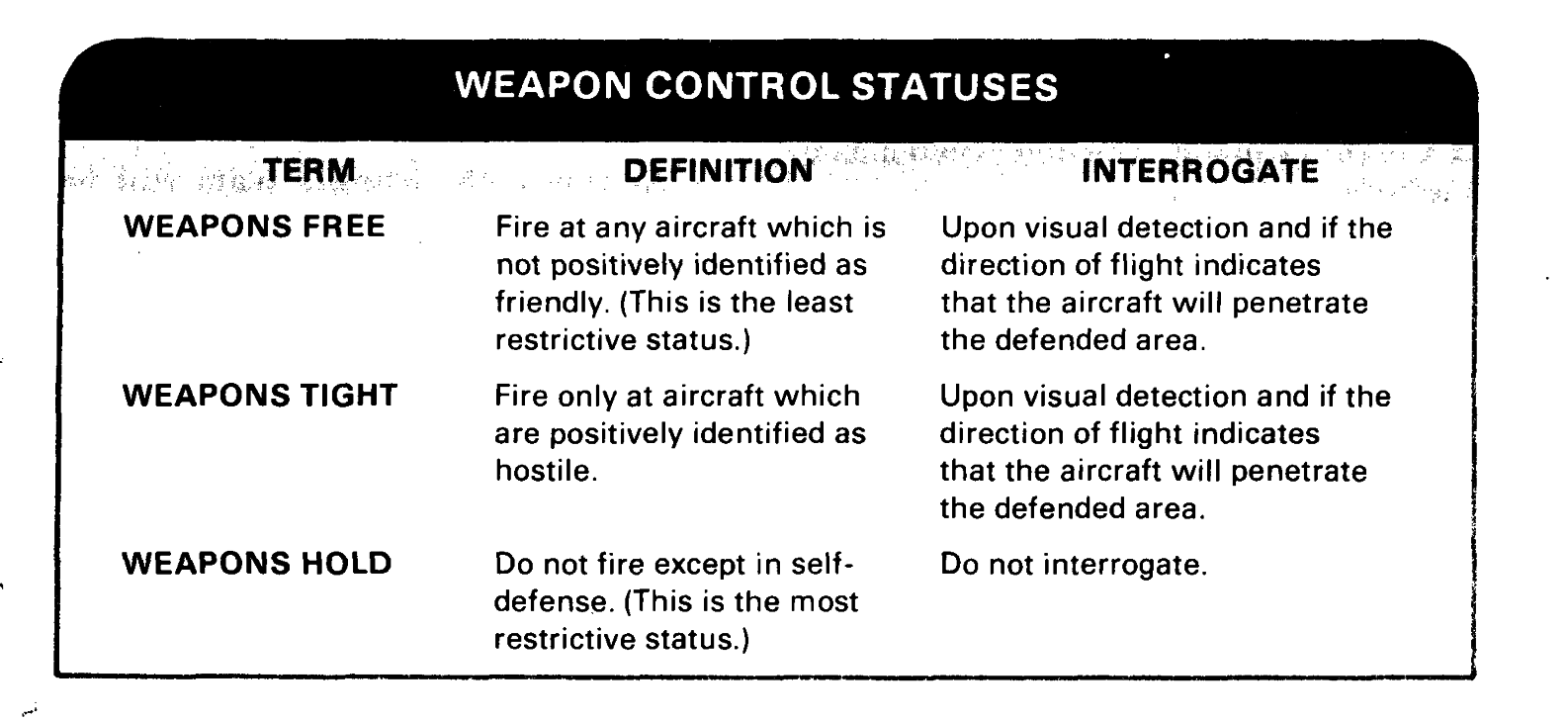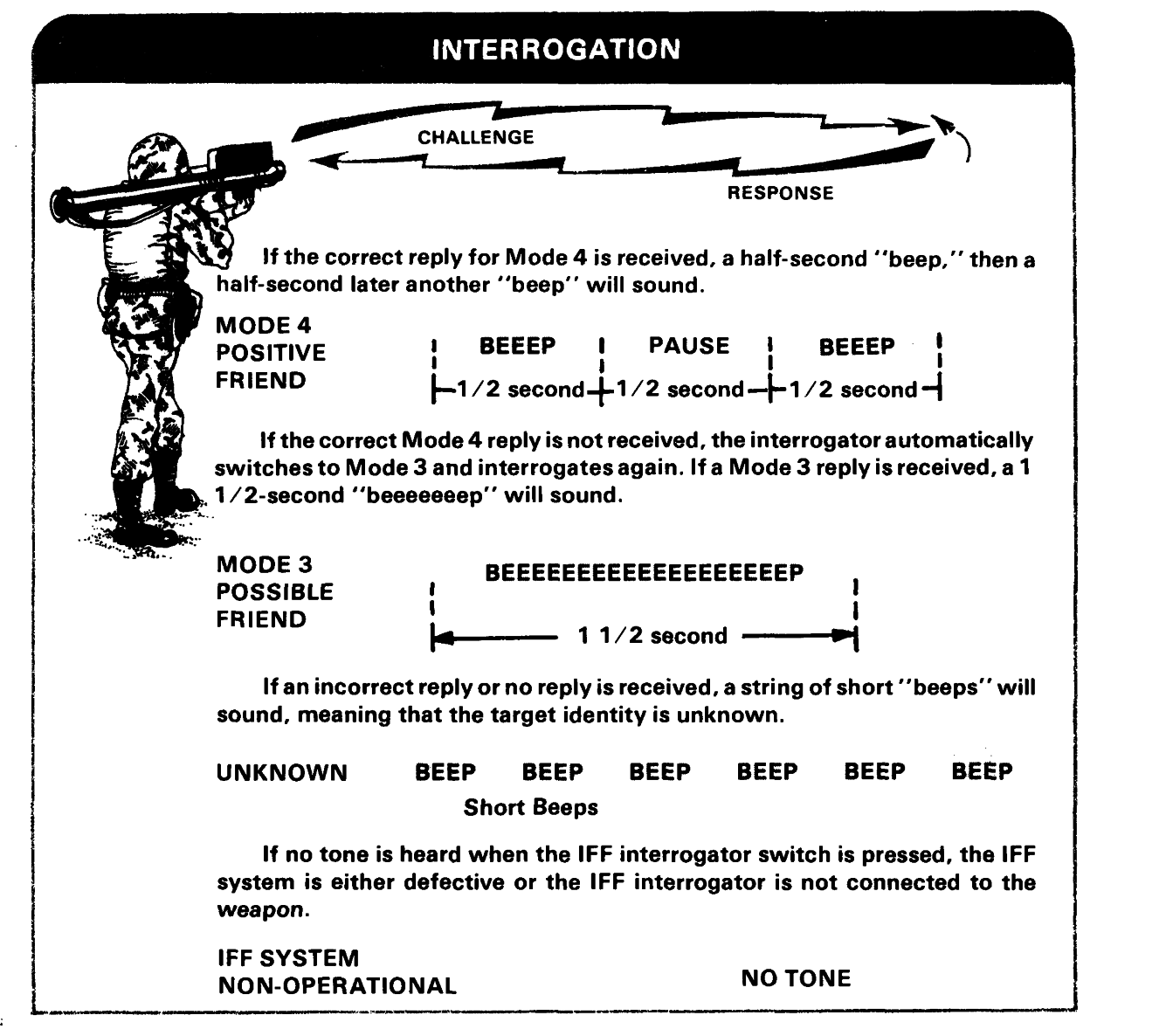


FM 44-18-1
TERRAIN MASKING
Since Stinger gunners are on the ground,
those flying above 1,200 feet or lower than
the local terrain will influence the distance at
150 feet.
which low-altitude aircraft will unmask; that
is, not be hidden behind a hill or other fea-
METEOROLOGICAL CONDITIONS
ture. Terrain mask should be kept in mind
when selecting a site.
Rain, snow, dust, fog, smoke, heat shim-
mer, and haze tend to reduce visibility and so
AIRCRAFT CHARACTERISTICS
tend to reduce the range of visual detection of
aircraft.
The main features of an aircraft that
affect detection range are—
VISUAL ACUITY
Size. The larger the target, the farther
away it can be detected. Apparent aircraft
Observers are required to detect, recog-
size varies with the type of aircraft and the
nize, and identify small objects at long
aspect from which it is viewed. A jet fighter
ranges. Therefore, they must have good eye-
flying a course directly toward an observer
sight. Their eyes should be rested periodi-
shows a small profile and can get quite close
cally (about every 15 minutes) to prevent
to the observer before it is detected. The same
fatigue and to maintain alertness. Binocu-
aircraft on a crossing course has a much
lars have little value in detection because
larger profile; therefore, it can be detected at a they have narrow fields of view. This in-greater range.
creases the time required to search a given
area of space. Binoculars may help to iden-
Color. The color of an aircraft affects the
tify a target after it has been detected. See
degree that the aircraft contrasts with the
appendix B for use of binoculars.
background. Some jet aircraft have a smoke
trail that can be used as an aid in detection at
SEARCH SECTOR
long ranges.
Search sectors should be as small as pos-
Speed. Aircraft speed affects visual detec-
sible and still have good coverage to both
tion of aircraft. Detection range decreases as
sides of the expected avenues of target
target speed increases.
approach. When alerted to an approaching
Altitude. Aircraft flying at altitudes of 150
target, the search sector should be reduced
to 1,200 feet (46 to 366 meters) above the
and concentrated in the general direction of
ground are detected at longer ranges than
the expected approach.
HOW TO SEARCH
An observer’s capability to detect air-
general surveillance. When a warning is
craft increases as the size of the search sector
received, he then narrows his search sector
assigned decreases. Detection is more likely
(for example, 30°) and centers it on the air-
if an observer is assigned responsibility for
craft’s approach azimuth. Decreasing the
searching a narrow sector than if he is respon-
sector size to less than 30° is not advisable
sible for searching the entire area surround-
because the alert warning system azimuth
ing his position. If an alert warnings system is
data may not be accurate. An error of only a
supporting the observer, he maybe assigned
few degrees may cause the observer to miss
a fairly large sector (for example, 90°) for
an aircraft. Often observers, using the hori-
4-2












FM 44-18-1
zon as a reference, tend to concentrate their
assigning search sectors, the sector should be
search near the horizon and disregard objects
defined in both horizontal and vertical planes.
high above the horizon. Therefore, when
A simple way to estimate how high above
perpendicular to the ground. Now, when the
the horizon to search is to use the hand.
little finger is touching the horizon, the tip of
Facing the PTL, extend either the left or right
the thumb is approximately 20° above the
arm fully and extend the fingers. The tips of
horizon.
the thumb and little finger should form a line
4-3









. .
FM 44-18-1
The observer should frequently focus his
The observer should keep his eyes on the
eyes on a distant object, such as a cloud or
aircraft once he sees it. If he has to look away
terrain feature (otherwise, the eyes tend to
from it, he notes the direction of the aircraft
relax and distant objects become blurred).
and moves his eyes away from it when the
aircraft is near some object, such as a cloud or
Search the area near the sun by extend-
a terrain feature, that will guide his eyes back
ing arm and hand as to block out the sun’s
to it.
glare. (Looking into the sun without shield-
Observers may use one of two systematic
ing the eyes will cause them to become blinded
methods of search to look for aircraft in any
for a few seconds. This may prove to be criti-
type of terrain.
cal, because the observer may lose sight of
the target.)
In the first method, the observer searches
the horizon to about 20° (356 roils) above the
The observer should squint his eyes if he
horizon by moving his eyes in short move-
has trouble focusing at long ranges. Squint-
ments across the sky, working his way up
ing compresses the eyeballs, thus changing
and across. He continues the scan pattern to
their focal length and making distant objects
below the horizon to detect aircraft flying
come into focus.
nap-of-the-earth.
4-4




FM 44-18-1
In the second method, the observer
continuing this movement across the terrain.
searches the sky using the horizon as a start-
He scans in the same pattern below the
ing point and prominent terrain features as
horizon to detect aircraft flying nap-of-
points of reference. He moves his eyes in
the-earth.
short movements up the sky, then back down,
Observers with more experience and
ing is received, both team members shift
above average visual efficiency may use
primary search emphasis to the azimuth of
nonsystematic methods of search that work
approach (with frequent all-around scans)
best for themselves such as—
until one member detects the target.
Combination of the two systematic
methods.
At times, the Stinger team will be
Search of the horizon in the shape of an
assigned a sector of responsibility by the
oval to about 20° above the horizon.
Stinger section chief or the supported unit
commander. When two or more teams are
General/random search of the horizon.
defending a unit in position behind the line of
When the Stinger team occupies a tacti-
contact, the Stinger team normally concen-
cal position, each team member will take
trates its search for aircraft along these
turns searching for aerial targets. This allows
avenues. At other times, the Stinger team will
one member to search while his partner rests
search for aircraft as specified by local SOP
his eyes and provides ground security. Search
or as required by the situation. This is com-
sectors are arranged to provide all-around
mon when a Stinger team is defending a con-
coverage of the entire area and overlapping
voy. This is also common when it is support-
coverage of the assigned sector of fire on
ing a maneuver unit which is in contact with
likely approach routes. When an alert warn-
or moving to contact with the enemy.
4-5





FM 44-18-1
WHERE TO SEARCH
A map reconnaissance of the supported
sonnel should also be constantly alert to the
unit’s direction of movement or area of opera-
possibility of attack by enemy aircraft. Again,
tion will help to pinpoint areas from which
the team chief marks the route of advance
aircraft are most likely to attack the unit.
and monitors the TADDS and the radio for
Mark the far sides of woodlines, ridgelines,
warnings of approaching aircraft.
and significant folds in the terrain out to at
least 3,000 to 5,000 meters. This is where
TELL-TALE SIGNATURES
attack helicopters can lie in wait at the max-
imum range of their antitank guided missiles
Many aircraft have tell-tale signatures
(ATGM). Mark restricting terrain-defiles
which can lead to early detection. Stinger
and narrow valleys—where the unit may be
teams should look for the following:
forced to pinch together, becoming lucrative
Sun reflection from aircraft canopies or
targets for air attack.
cockpit windows.
Blade flash from rotating helicopter blades.
WITH MANEUVER UNITS
Smoke or vapor trails from jet aircraft and
When accompanying maneuver units in
missile or rockets fired from aircraft.
contact or moving to contact with the enemy,
the Stinger team usually concentrates its
Dust or excessive movement of tree tops
search for aircraft in the general direction of
and bushes in a particular area.
the enemy ground forces and occasionally
Noise from helicopter blades or from jets
searches the entire horizon. Other unit per-
breaking the sound barrier.
AIRCRAFT INTERROGATION
Exactly when to interrogate an aircraft
are shown in the illustration below.
depends upon the WCS in effect. The WCSs
4-6




FM 44-18-1
Rules of engagement do not prohibit a
the aircraft in the range ring.
unit or air defense weapon from shooting at
As soon as the target is in the range ring,
an aircraft that is attacking it—the right of
press the challenge switch. After triggering,
self-defense is never denied. (The engage-
the IFF operation is completely automatic.
ment decision is covered in chapter 5.)
The following shows in words and gra-
Interrogation techniques are as follows:
phics the IFF tone responses.
Aim the weapon at the target and center
4-7



FM 44-18-1
AIRCRAFT IDENTIFICATION
Firing a Stinger missile at an aircraft
Attacking friendly elements. Any aircraft
must be IAW specific hostile criteria. (Nor-
actively attacking the team or supported unit
mally, the responsibility for target identifica-
or installation may be identified as hostile.
tion rests with the team chief.) The identifica-
The right of self-defense is never denied.
tion must be completed before the team chief
Responding improperly to IFF interroga-
can issue a command to engage. The gunner
tion. The gunner issues an IFF challenge to
may complete the engagement sequence up to
the target by pressing the IFF CHALLENGE
firing, but he will not fire without having first switch. If the target responds improperly to
received an order to engage from the team
the challenge, the team chief may accept the
chief. When operating as part of a split team
improper response as a first assumption of
or if the team chief becomes a casualty, the
hostility. However, the team chief must then
gunner must assume identification responsi-
successfully apply at least one more hostile
bilities. After an aircraft has been detected, it
criteria based on visual observation of the
must be identified as friendly, hostile, or
aircraft before making a final identification
unknown.
of the aircraft as hostile.
If the aircraft is declared friendly, it must
Note: If the WCS is WEAPONS FREE, gun-
not be engaged (except in self-defense).
ners will engage aircraft responding improp-
If the aircraft is declared hostile and is
erly to IFF interrogation unless constrained
within range, it must be destroyed (except
by headquarters/command directives/SOPs.
under a condition of WEAPONS HOLD).
Performing any of the following acts over
However, the right to fire in self-defense is
friendly troops or territory without prior
never denied.
coordination:
If the aircraft is unknown, the engage-
❐ Discharging smoke or spray.
ment decision is based on the WCS, applica-
❐
tion of hostile criteria and techniques of fire.
Discharging parachutists or unloading
troops in excess of normal aircraft crew.
HOSTILE CRITERIA
❐ Engaging in mine-laying operations.
Recognition of the aircraft by name or
ADDITIONAL CONSIDERATIONS
country of manufacture is a start, but it is
Unauthorized or improper entry into an
by no means conclusive. For example, the
area designated as restricted or prohibited
Mirage III/V is made in France; however, it
could prove dangerous or lead to personnel
is in service in 23 countries in Europe, the
injury and aircraft loss. Care should be exer-
Middle East, Africa, Australia, and South
cised in applying this criterion. This is neces-
America. Other aircraft are similarly spread
sary to avoid engaging a friendly aircraft
throughout the world, including many made
that has been damaged and is retiring to the
in the United States. Target identification as
rear of our lines. Also, it may have inadvert-
hostile must be based on visual inspection of
ently strayed into the restricted area due to a
the target and its assessment against specific
navigational error.
hostile criteria. The exact criteria in use may
vary with the tactical situation, from com-
Aircraft operating at prohibited speeds
mand to command, and in terms of time and
or altitudes, or in prohibited directions, can
space. For example, the TSOP may classify
pose a real problem to an observer. The
as hostile those aircraft that are—
determination of aircraft speed and altitude
4 - 8
FM 44-18-1
by ground observers is difficult. Extreme care
markings are not usually visible at long
should be used in applying this criterion.
ranges, most identifications must be made on
An aircraft bearing the military mark-
recognition of the physical features of the
ings or having the configuration of an air-
aircraft. To eliminate any element of doubt,
craft employed by a known enemy nation
both team members must be capable of rec-
may also pose a real problem to the Stinger
ognizing friendly as well as enemy aircraft.
missile team. In this case, the criteria used by
(For detailed discussion of aircraft recogni-
the Stinger team must be based on visual
tion, refer to FM 44-30.)
inspection of the aircraft. Since aircraft
4-9
CHAPTER 5
The Engagement Decision
When the team chief or gunner has made an identification of a target as hostile, or (under certain conditions) as unknown, and all other requirements for engagement are met, the team chief makes the engagement decision.
THE STINGER MISSION
The mission of the Stinger team is to pro-
full Stinger fielding is accomplished). Stinger
tect the unit which it is supporting from
teams supporting maneuver units provide
attack by aircraft. To be successful in their
such units with an additional means of air
mission, the team members must work to-
defense.
gether as a team. In this chapter the actions
and decisions made by the team chief and the
COMMAND AND CONTROL
gunner during an engagement sequence are
explained. These actions and decisions must
The Stinger teams are commanded and
be understood by both team members prior to
controlled by the section chief. The section
and during an engagement.
chief controls his teams during field opera-
tions through use of a detailed TSOP. This
STINGER TEAM
method of control is used because the teams
are usually located at long distances from the
The basic combat unit is the Stinger
section chief’s command post. Therefore,
team. The team consists of a team chief and a
direct and personal supervision of each team
gunner. Both team members are trained as
normally is not possible. The link between
gunners and in communications, target detec-
the section chief and his teams is a tactical
tion, and aircraft recognition. During periods
of intense air activity, both may act as gun-
ners to increase the rate of fire. A basic load of CONTENTS
six Stinger weapons (four weapon-rounds
Page
and two missile-rounds) are carried by each
The Stinger Mission . . . . . . . . . . . . . . . . . . .5-1
team, initially, during combat operations.
Method of Engagement . . . . . . . . . . . . . . . .5-2
Resupply will normally be with Redeye (until
5-1






FM 44-18-1
radio net. Over this net the section chief
to fire by use of WCS and fire control orders.
maneuvers his team and obtains information
Further details on command and control are
on their status and location. He also modifies
found in FM 44-18. The fire control orders used
their state of readiness by changing the air
by team chiefs are shown in the illustration.
defense warning and controls their freedom
TEAM CHIEF
The Stinger team chief is responsible for
selecting the method of engagement to be
the decision to engage. He must make the
used and selecting the specific target to be
decision based on rules of engagement con-
engaged.
tained in the unit TSOP and with criteria
In the event that the gunner is alone, he
given to him by the section chief. In addition
to identifying the target, he is responsible for
engages the most threatening target first.
METHOD OF ENGAGEMENT
The method used to engage aircraft
flying the same course, at the same speed,
depends upon their number. A multiple
less than 1,000 meters apart. All other raids
target raid is a raid by two or more aircraft
are single target raids.
5-2

















































